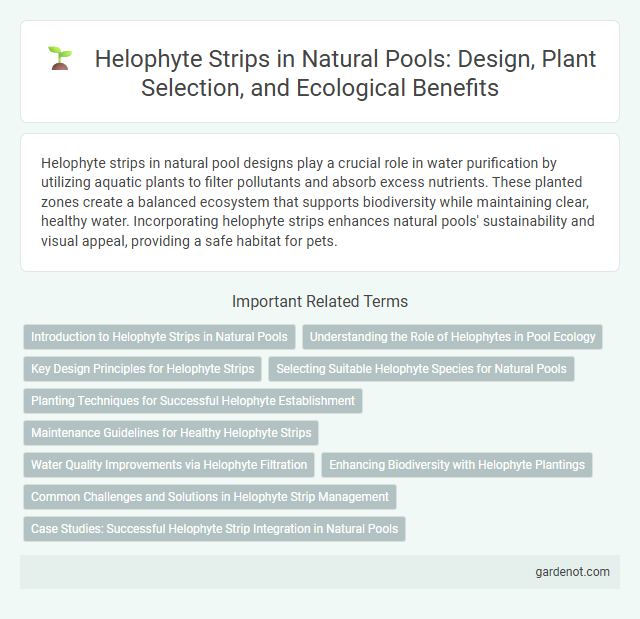Helophyte strips in natural pool designs play a crucial role in water purification by utilizing aquatic plants to filter pollutants and absorb excess nutrients. These planted zones create a balanced ecosystem that supports biodiversity while maintaining clear, healthy water. Incorporating helophyte strips enhances natural pools' sustainability and visual appeal, providing a safe habitat for pets.
Introduction to Helophyte Strips in Natural Pools
Helophyte strips are essential components in natural pools, serving as biological filters that improve water quality by removing nutrients and pollutants. These planted zones consist of water-loving vegetation such as reeds, cattails, and sedges, which facilitate nutrient uptake and provide habitat for beneficial microorganisms. By enhancing natural purification processes, helophyte strips contribute to maintaining clear, balanced, and healthy aquatic ecosystems within natural swimming pools.
Understanding the Role of Helophytes in Pool Ecology
Helophytes play a crucial role in natural pool ecology by filtering pollutants and providing habitat for beneficial microorganisms that maintain water quality. Their extensive root systems enhance nutrient uptake, reducing algae growth and supporting biodiversity within the ecosystem. By stabilizing sediment and improving oxygen levels, helophyte strips contribute to the natural purification processes essential for sustainable pool health.
Key Design Principles for Helophyte Strips
Helophyte strips in natural pool design rely on specific key principles such as selecting native, robust macrophyte species capable of thriving in fluctuating water levels. Proper substrate layering with gravel and sand facilitates optimal root stabilization and nutrient absorption, enhancing water filtration efficiency. Strategic placement along pool edges ensures maximum pollutant uptake and supports biodiversity by creating microhabitats for aquatic fauna.
Selecting Suitable Helophyte Species for Natural Pools
Selecting suitable helophyte species for natural pools involves prioritizing native plants such as common reed (Phragmites australis), bulrush (Schoenoplectus spp.), and cattail (Typha latifolia) due to their robust filtration and oxygenation capabilities. These helophytes thrive in shallow water zones, enhancing nutrient uptake and providing natural water purification while supporting biodiversity. Ensuring species adaptability to local climate and water conditions optimizes the ecological balance and aesthetic integration of the helophyte strip in natural pool systems.
Planting Techniques for Successful Helophyte Establishment
Helophyte strip planting involves selecting native wetland plants with strong root systems to stabilize the substrate and enhance water filtration in natural pools. Planting techniques emphasize firm anchoring in nutrient-rich, well-prepared soil along the pool's shallow edges to promote rapid establishment and growth. Regular monitoring and adaptive maintenance such as thinning and replanting ensure the helophyte strip develops into a dense, self-sustaining biofilter that supports ecosystem balance.
Maintenance Guidelines for Healthy Helophyte Strips
Regular removal of dead plant material and debris ensures efficient nutrient uptake and prevents stagnation in helophyte strips. Maintaining optimal water levels between 10-30 cm supports plant root oxygenation and microbial activity essential for natural filtration. Periodic inspection for invasive species and replanting native helophytes preserves biodiversity and enhances water purification in natural pools.
Water Quality Improvements via Helophyte Filtration
Helophyte strips play a crucial role in natural pool ecosystems by enhancing water quality through biological filtration. These plant-based zones act as natural biofilters, absorbing excess nutrients and breaking down organic pollutants, which reduces algae growth and maintains clear water. The root systems of helophyte plants foster beneficial microbial activity, further decomposing contaminants and stabilizing the aquatic environment.
Enhancing Biodiversity with Helophyte Plantings
Helophyte strips in natural pools serve as vital ecological zones that enhance biodiversity by providing habitat and food sources for various aquatic and terrestrial species. These plantings, including species like cattails, reeds, and sedges, support microbial communities that improve water quality through natural filtration. Integrating helophyte zones increases the ecological complexity of the pool, fostering a balanced aquatic ecosystem and promoting sustainable water purification.
Common Challenges and Solutions in Helophyte Strip Management
Helophyte strip management often faces challenges such as nutrient overload, invasive species encroachment, and uneven plant growth, which can compromise water purification and habitat quality. Regular monitoring, selective harvesting, and the introduction of native plant species help mitigate these issues by maintaining ecological balance and enhancing nutrient uptake. Implementing controlled water flow and periodic sediment removal further supports optimal helophyte strip function and longevity in natural pool systems.
Case Studies: Successful Helophyte Strip Integration in Natural Pools
Case studies of successful helophyte strip integration in natural pools reveal enhanced water purification and biodiversity support. Notable examples include the Kootenay Helophyte Project in Canada, where native plants like cattails and bulrushes improved filtration efficiency by 40%, and the Swiss Ecological Garden, which demonstrated significant reductions in nitrate levels through helophyte-root systems. These projects highlight the ecological and aesthetic benefits of helophyte strips in maintaining balanced aquatic environments.
Helophyte strip Infographic

 gardenot.com
gardenot.com